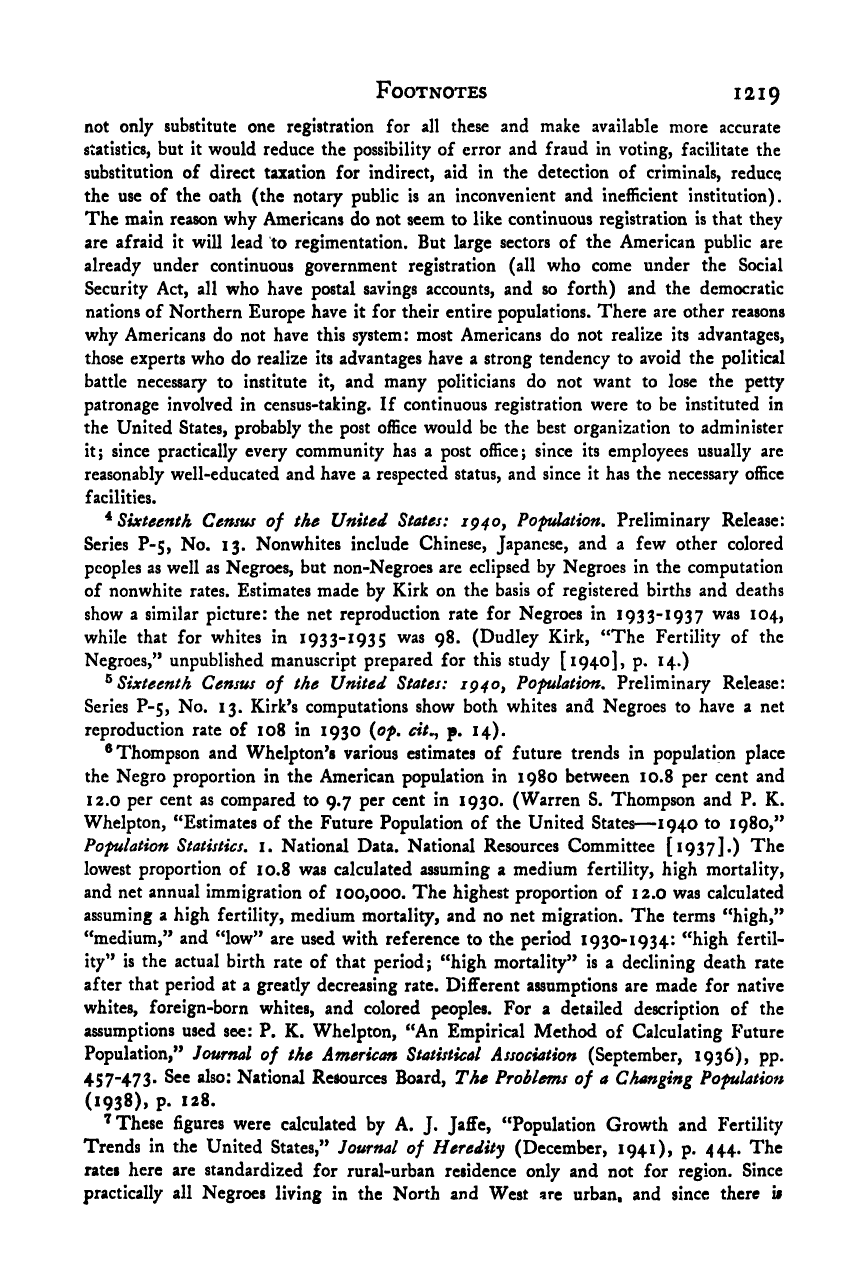Note: Gunnar Myrdal died in 1987, less than 70 years ago. Therefore, this work is protected by copyright, restricting your legal rights to reproduce it. However, you are welcome to view it on screen, as you do now. Read more about copyright.
Full resolution (TIFF) - On this page / på denna sida - Footnotes - Chapter 7

<< prev. page << föreg. sida << >> nästa sida >> next page >>
Below is the raw OCR text
from the above scanned image.
Do you see an error? Proofread the page now!
Här nedan syns maskintolkade texten från faksimilbilden ovan.
Ser du något fel? Korrekturläs sidan nu!
This page has never been proofread. / Denna sida har aldrig korrekturlästs.
Footnotes 1219
not only substitute one registration for all these and make available more accurate
statistics, but it would reduce the possibility of error and fraud in voting, facilitate the
substitution of direct taxation for indirect, aid in the detection of criminals, reduce
the use of the oath (the notary public is an inconvenient and inefficient institution).
The main reason why Americans do not seem to like continuous registration is that they
are afraid it will lead to regimentation. But large sectors of the American public are
already under continuous government registration (all who come under the Social
Security Act, all who have postal savings accounts, and so forth) and the democratic
nations of Northern Europe have it for their entire populations. There are other reasons
why Americans do not have this system: most Americans do not realize its advantages,
those experts who do realize its advantages have a strong tendency to avoid the political
battle necessary to institute it, and many politicians do not want to lose the petty
patronage involved in census-taking. If continuous registration were to be instituted in
the United States, probably the post office would be the best organization to administer
it; since practically every community has a post office; since its employees usually are
reasonably well-educated and have a respected status, and since it has the necessary office
facilities.
^ Sixteenth Census of the United States: ig4o, Population. Preliminary Release:
Series P-5, No. 13. Nonwhites include Chinese, Japanese, and a few other colored
peoples as well as Negroes, but non-Negroes are eclipsed by Negroes in the computation
of nonwhite rates. Estimates made by Kirk on the basis of registered births and deaths
show a similar picture: the net reproduction rate for Negroes in 1933-1937 was 104,
while that for whites in 1933-1935 was 98. (Dudley Kirk, “The Fertility of the
Negroes,” unpublished manuscript prepared for this study [1940], p. 14.)
^Sixteenth Census of the United States: 1940^ Population. Preliminary Release:
Series P-5, No. 13. Kirk’s computations show both whites and Negroes to have a net
reproduction rate of 108 in 1930 {of. cit.^ p. 14).
® Thompson and Whelpton’s various estimates of future trends in population place
the Negro proportion in the American population in 1980 between 10.8 per cent and
12.0 per cent as compared to 9.7 per cent in 1930. (Warren S. Thompson and P. K.
Whelpton, “Estimates of the Future Population of the United States—1940 to 1980,”
Population Statistics, i. National Data. National Resources Committee [1937].) The
lowest proportion of 10.8 was calculated assuming a medium fertility, high mortality,
and net annual immigration of 100,000. The highest proportion of 12.0 was calculated
assuming a high fertility, medium mortality, and no net migration. The terms “high,”
“medium,” and “low” are used with reference to the period 1930- 1934: “high fertil-
ity” is the actual birth rate of that period; “high mortality” is a declining death rate
after that period at a greatly decreasing rate. Different assumptions are made for native
whites, foreign-born whites, and colored peoples. For a detailed description of the
assumptions used see: P, K. Whelpton, “An Empirical Method of Calculating Future
Population,” Journal of the American Statistical Association (September, 1936), pp.
457“
473 * See also: National Resources Board, The Problems of a Changing Population
(1938), p. 128.
These figures were calculated by A. J. Jaffe, “Population Growth and Fertility
Trends in the United States,” Journal of Heredity (December, 1941), p. 444. The
rates here are standardized for rural-urban residence only and not for region. Since
practically all Negroes living in the North and West are urban, and since there is
<< prev. page << föreg. sida << >> nästa sida >> next page >>